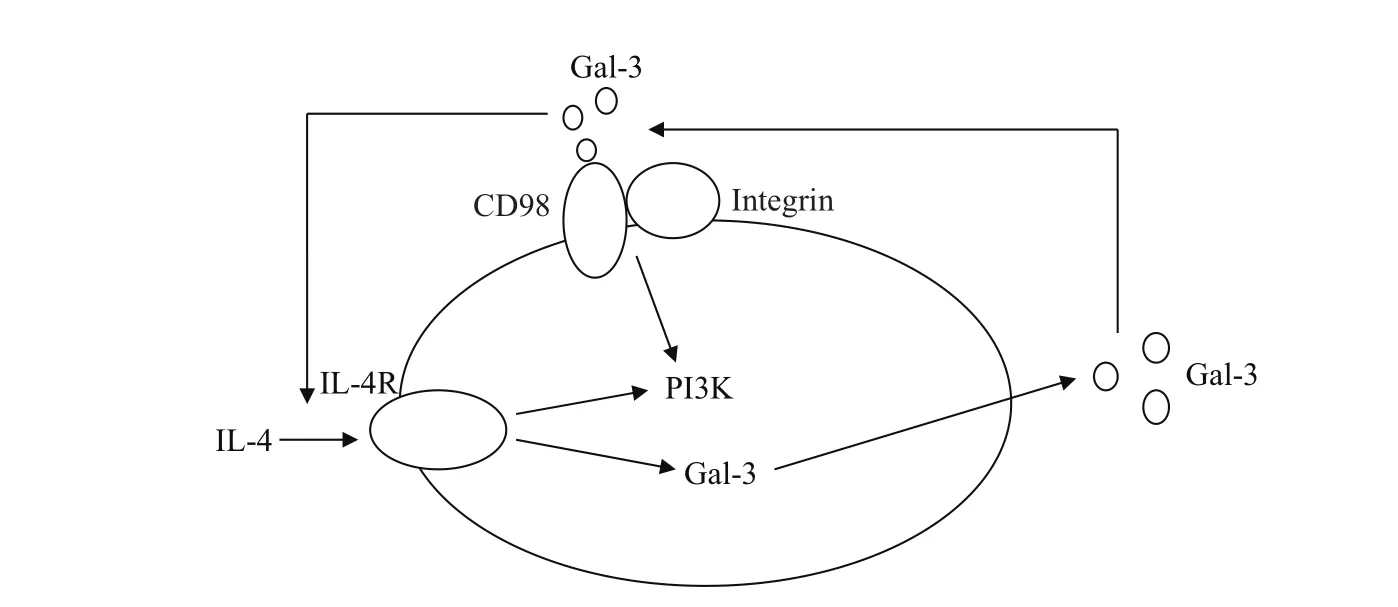半乳糖凝集素-3与巨噬细胞炎性反应的关系
2017-07-19刘仲尼杨力明
刘仲尼,杨力明
(哈尔滨医科大学基础医学院病理生理学教研室,哈尔滨 150081)
半乳糖凝集素-3与巨噬细胞炎性反应的关系
刘仲尼,杨力明
(哈尔滨医科大学基础医学院病理生理学教研室,哈尔滨 150081)
半乳糖凝集素-3(Galectin-3,Gal-3)是一种30 kDa左右且高度保守的β-半乳糖蛋白,在人体各组织及微环境内广泛存在.由于Gal-3特有的糖识别结构域和高度保守的N-端结构域,使其具有可塑性强和功能多样化的特点,并在人体内作为特殊中介物参与炎症反应.巨噬细胞作为主要的炎性反应细胞对调节炎症反应起关键作用.主要介绍Gal-3作为炎性细胞因子在炎症中与巨噬细胞的关系及研究进展.
半乳糖凝集素- 3;巨噬细胞;炎症
半乳糖凝集素是一种糖结合蛋白,以高度保守的N-端氨基酸序列和特异性识别的β-半乳糖苷结构为突出特点[1],受到了国内外研究者的广泛关注.凝集素共分为三类:动物凝集素、植物凝集素、微生物凝集素,半乳糖凝集素-3(Galectin-3,Gal-3)属于动物凝集素.已有很多研究证实,Gal-3可作为炎性因子通过细胞激活、迁移以及调节免疫机制来参与炎症反应,而巨噬细胞是参与多种免疫反应的主要炎症调节细胞.Papaspyridonos等[2]发现巨噬细胞大量表达Gal-3,因此Gal-3和巨噬细胞间存在密切关系.
1 Gal-3的生物学特性
Gal-3是唯一存在于脊椎动物且只包含一个糖识别结构域(carbohydrate recognition domain,CRD)的半乳糖凝集素,最早被命名为Mac-2抗原,首次于经过处理的小鼠腹腔巨噬细胞中被发现.Mac-2由251个氨基酸残基组成,包含两个结构域:一个是由约120个氨基酸组成的N-端结构域,含有高度重复的串联序列[3],重复序列被基质金属蛋白酶(matrix metalloproteinase,MMP)剪切导致CRD对复合糖等配体的亲和力上升,从而使Gal-3易于形成低聚物[4];另一个是由130个氨基酸组成的类球形CRD,它对β-半乳糖苷具有较强的亲和力,并通过调节糖类结合位点使Gal-3参与炎性细胞增殖凋亡及糖配体识别等生理过程.另外,Gal-3还可介导分子间相互作用,交联不同细胞表面糖蛋白,介导细胞间或细胞与细胞外基质蛋白间的结合,从而调节细胞间粘附作用或诱导细胞迁移.
2 Gal-3的分布
Gal-3缺乏由内质网囊泡介导的细胞外分泌信号肽,因此不能通过经典途径分泌到细胞外,只能通过非经典途径释放到细胞外间隙[5-6].绝大部分的Gal-3位于细胞质内,尤其是作为炎症因子广泛存在于炎性细胞中,少量表达在细胞核及线粒体,一小部分Gal-3被分泌到细胞外.已有研究表明,Gal-3表达于多种组织细胞中,包括消化道、子宫内膜及呼吸道上皮细胞、成纤维细胞和各组织内皮细胞等[7-8].另外,在多种组织的巨噬细胞及单核细胞中均能检测到Gal-3的表达,这表明Gal-3与巨噬细胞间存在密切关系[9].
3 炎症中的巨噬细胞
巨噬细胞是炎性反应中主要的调节细胞,当宿主处于感染早期时,巨噬细胞的主要作用是清除病原体.然而炎症是把“双刃剑”,在清除病原体的同时也会损伤正常组织,因此组织修复和适时的炎症抑制在炎症后期对正常组织有重要的保护作用.已有研究认为巨噬细胞只发挥促炎作用,但实际上巨噬细胞是一种多相性细胞,不同分化类型的巨噬细胞可调节机体炎症状态并维持其内在平衡.在炎症的不同阶段,组织微环境的改变及细胞因子变化会诱导巨噬细胞分化,从而介导促炎或抑炎反应[10].通过干扰素-γ及细菌脂多糖(lipopolysaccharides, LPS)等Th1细胞因子活化的经典巨噬细胞为Ⅰ型巨噬细胞(M1),主要在炎症早期发挥促炎作用;通过白介素-4(IL-4)、白介素-13(IL-13)等Th2细胞因子活化的非经典巨噬细胞为Ⅱ型巨噬细胞(M2),在炎症后期抑制炎症过度反应并促进组织修复[11].
4 Gal-3在急性巨噬细胞相关炎性反应中的作用
4.1 Gal-3调节巨噬细胞的促/抑炎功能
近年来,肺炎链球菌型急性肺炎在全球范围内的发病率逐渐升高,抗生素作为传统的治疗手段,随着病菌耐药性的提升,其治疗效果逐渐减弱[12].当肺部感染肺炎球菌时,肺泡巨噬细胞作为第一道防线发挥了重要作用:一方面在炎症早期胞吞病菌及病菌感染的细胞;另一方面促进中性粒细胞吞噬肺炎链球菌,并使中性粒细胞产生细胞毒性产物[13].但是细胞毒性产物在杀伤病原的同时也会损伤正常组织.在炎症后期反应过度时,巨噬细胞会吞噬凋亡的中性粒细胞和细胞残骸来抑制炎症.已有研究表明,Gal-3在炎症早期和晚期能发挥相反的作用,在肺炎链球菌感染的肺泡中检测到了大量Gal-3沉积并伴随有中性粒细胞外溢.另外与肺炎链球菌膜分离物一起培养的肺泡巨噬细胞中有大量Gal-3的存在[14],这表明Gal-3在巨噬细胞及中性粒细胞发挥免疫功能的过程中起到一定的作用.Farnworth等[15]通过建立感染肺炎链球菌的Gal-3基因敲除鼠模型,发现基因敲除鼠的肺组织损伤比普通小鼠组严重,注射Gal-3后,基因敲除鼠肺组织损伤明显受到控制,从而也证明了Gal-3对巨噬细胞相关炎性反应有调节作用.体外实验也证明,经巨噬细胞大量表达的Gal-3可增强下游中性粒细胞的胞吞作用从而起到促炎作用.同时发现Gal-3基因敲除的巨噬细胞对炎症后期凋亡中性粒细胞的胞吞作用弱于正常巨噬细胞,从而指出Gal-3不仅对巨噬细胞及中性粒细胞有促炎作用,还可增强巨噬细胞的胞吞能力,清理中性粒细胞以防止过度炎症反应.由此可见,Gal-3对巨噬细胞相关炎症反应有重要调控作用.
随着相关研究的不断深入,近年来有学者提出了Gal-3调节巨噬细胞相关炎性反应的分子机制.Fermino等[16]指出巨噬细胞分泌的Gal-3可与LPS相互作用并上调CD11b和活性氧的表达,从而增强LPS与中性粒细胞表面之间的亲和力并激活中性粒细胞.另有研究表明, Gal-3可结合N-乙酰氨基乳糖(一种存在于巨噬细胞表面糖蛋白的糖类)来促进巨噬细胞吞噬凋亡的中性粒细胞[17].然而确切的分子机制还不清楚,需要进一步研究.
4.2 Gal-3趋化单核/巨噬细胞
Gal-3的趋化特性在巨噬细胞炎性反应中起关键作用.Sano等[18]发现Gal-3在高浓度下可以诱导单核细胞及巨噬细胞向Gal-3密集区迁移,然而在低浓度下却有相反的效果,并且Gal-3的趋化作用可以被乳糖或作用于N-端结构域的Gal-3抗体抑制,表明Gal-3的N-端结构域和CRD都参与趋化反应.与此同时,体内实验也得到了相同的结果.Gal-3趋化作用能促进巨噬细胞炎症的发展,当机体受损部位有病原体入侵时,巨噬细胞表达的Gal-3会吸引外周血中其他巨噬细胞到达受损部位,从而加强炎性反应.然而,Gal-3趋化作用的促炎特性也可以加剧某些疾病的发展,比如在动脉粥样硬化斑块中集聚的巨噬细胞会释放Gal-3,并吸引血液中的单核细胞和巨噬细胞到达斑块部位从而加剧斑块的不稳定性.因此,Gal-3可作为一个全新靶点,通过调控其趋化特性治疗巨噬细胞相关疾病.
4.3 Gal-3调节巨噬细胞凋亡
Gal-3在巨噬细胞炎性反应中对其凋亡具有调节作用,而且Gal-3对凋亡的调节作用与巨噬细胞的相对位置有密切关系.已有研究显示,位于T细胞内的Gal-3可以明显抑制T细胞的凋亡,从而增强T细胞的免疫功能[19],T细胞外的Gal-3有明显的促凋亡作用[20].Hsu等[21]在巨噬细胞上也发现了相同的现象,Gal-3−/−小鼠的腹腔原代巨噬细胞相比于正常巨噬细胞更易发生凋亡,无Gal-3表达到细胞外的RAW264.7巨噬细胞被诱导凋亡的效果明显下降[22],所以Gal-3参与了巨噬细胞凋亡的调节过程.虽然如此,关于Gal-3调节巨噬细胞凋亡的确切机制还需要进一步研究.
5 Gal-3调节巨噬细胞M2型分化
巨噬细胞分为M1型和M2型,其中M2型巨噬细胞参与哮喘、纤维化、组织修复、动脉粥样硬化等多领域疾病的发展过程[23-25].已有研究者通过建立卵白蛋白诱导的哮喘小鼠模型指出,无Gal-3表达的小鼠能引起较高水平的Th1反应,而Th2反应的水平较低[26],证明了Gal-3参与调节M2型巨噬细胞分化.
CD98是一种异源二聚体式的Ⅱ型跨膜糖蛋白,在巨噬细胞膜上表达的CD98可以作为Gal-3的受体[27].Rintoul等[28]和Henderson等[29]的研究表明,CD98与巨噬细胞膜上的β1整联蛋白交联在一起,受到4F2抗体刺激时CD98-整联蛋白复合体能够激活肌醇磷脂3-激酶(PI3K),从而激活其下游的信号通路,诱导M2型巨噬细胞的分化.同时在Gal-3基因敲除的129sv小鼠骨髓原代巨噬细胞中,M2型巨噬细胞明显减少,而M1型的数量却没有受到影响[30].正常小鼠内被激活的M2型巨噬细胞表达大量Gal-3且其表达量明显高于其他M2型标记,反之,M1型巨噬细胞表达则降低.Mackinnon等[30]通过干扰RNA影响Gal-3,CD98和抑制PI3K的实验发现,M2型巨噬细胞分化均被抑制;针对CRD的特异性,Gal-3糖结合抑制剂也可以抑制IL-4诱导的M2型分化.上述研究证明,Gal-3通过结合CD98复合体在4F2抗体的作用下激活PI3K通路,从而激活M2型巨噬细胞,而且CRD在这一过程中起到了重要作用(见图1).另外,细胞外的Gal-3可以通过限制细胞膜内受体的迁移来延长作用时间,作用后的Gal-3可在IL-4的介导下被巨噬细胞内吞以避免细胞间隙酶类的降解,被内吞的Gal-3释放后可再次作用于CD98受体[31].

图1 Gal-3介导的M2型巨噬细胞分化模式Fig.1 Model of Gal-3 mediated M2 macrophage differentiation
6 Gal-3在慢性巨噬细胞相关炎性反应中的作用
当炎症长期反复发作便会转为慢性并损伤机体,早期从炎症转变为纤维化,组织正常结构改变,最终导致器官衰竭.在组织纤维化的进程中,巨噬细胞对其发生发展起到了重要作用,而巨噬细胞相关炎症因子Gal-3与纤维化的关系受到了学者的广泛关注.
Henderson等[32]通过建立肾纤维化小鼠模型发现肾纤维化小鼠体内Gal-3高表达,并且Gal-3缺失能够抑制肾纤维化,同时特异性删除巨噬细胞的CD11b-DTR转基因鼠被诱导肾纤维化的程度明显降低.另外,被移植野生型巨噬细胞的Gal-3基因敲除鼠恢复了纤维化.上述实验证明,巨噬细胞及其表达的Gal-3在纤维化的发展中起重要作用.Henderson等[32]还以Gal-3−/−巨噬细胞上清液为基质培养野生型巨噬细胞与成纤维细胞,实验结果证明巨噬细胞分泌的Gal-3能激活成纤维细胞从而促进纤维化的发展.这些研究表明,Gal-3能够促进有巨噬细胞参与的慢性纤维化过程.Vergaro等[33]指出Gal-3与醛固酮的协同作用可促进巨噬细胞浸润和纤维化的发展,也有研究表示Gal-3促进巨噬细胞相关的纤维化过程可能与白介素-33的介导有关[34],但是具体的分子机制尚未得到明确解释.
已有研究显示,M2型巨噬细胞的分化对纤维化的发展有促进作用,IL4/IL13诱导的M2型巨噬细胞提高了纤维化相关基因的表达[35-36]并且还能刺激纤维连结蛋白及其他细胞外基质蛋白的产生[37-38].Liu等[36]也提到经处理缺乏IL-4,IL-13或IL-4受体的小鼠肺纤维化明显减弱.上述研究证明,Gal-3,M2型巨噬细胞及纤维化三者间存在密切联系,但这三者间的相互作用机制还有待深入研究.
7 展望
Gal-3作为炎症不同阶段功能多样的炎性因子,在早期促进巨噬细胞相关炎性反应,增强免疫;在晚期抑制巨噬细胞相关炎性反应,促进组织修复.Gal-3还可趋化巨噬细胞,调节巨噬细胞凋亡、分化,促进巨噬细胞相关慢性纤维化.Gal-3对巨噬细胞相关炎症的重要调节作用体现出巨大的研究价值,然而Gal-3在巨噬细胞相关炎性反应中的作用机制还需深入探讨.PI3K作为经典自噬通路中重要的一环可受Gal-3的调控,这预示着Gal-3与自噬间可能存在重要联系.另外,Gal-3的多样功能在很大程度上依靠基质金属蛋白酶(matrix metall proteinase,MMP)对其N-端结构域的修饰来实现,已有研究指出经MMP-7作用后的Gal-3可加剧炎症反应抑制组织修复[39],因此MMP也可看作是一个探究Gal-3在巨噬细胞相关炎性反应中作用的新视角.同时,对Gal-3与巨噬细胞相关炎性反应的深入研究不仅在基础领域有重要意义,在临床领域譬如动脉粥样硬化等巨噬细胞相关疾病的治疗方面也具有指导意义.
[1]Barondes S H,Castronovo V,Cooper D N,et al.Galectins:a family of animal betagalactoside-binding lectins[J].Cell,1994,76(4):597-598.
[2]Papaspyridonos M,McNeill E,Bono J P D,et al.Galectin-3 is an amplifier of inflammation in atherosclerotic plaque progression through macrophage activation and monocyte chemoattraction[J].Arterioscler Thromb Vasc Biol,2008,28(3):433-440.
[3]Woo H J,Shaw L M,Messier J M,et al.The major non-integrin laminin binding protein of macrophages is identical to carbohydrate binding protein 35(Mac-2)[J].Journal of Biological Chemistry,1990,265(13):7097-7099.
[4]Ochieng J,Green B,Evans S,et al.Modulation of the biological functions of galectin-3 by matrix metalloproteinases[J].Biochimica Et Biophysica Acta,1998,1379(1):97-106.
[5]Liu F T,Patterson R J,Wang J L.Intracellular functions of galectins[J].Biochimica Et Biophysica Acta,2002,1572(2/3):263-273.
[6]Hughes R C.Secretion of the galectin family of mammalian carbohydrate-binding proteins[J]. Biochimica Et Biophysica Acta,1999,1473(1):172-185.
[7]Hrdlickovacela E,Plzak J,Smetana K,et al.Detection of galectin-3 in tear fluid at disease states and immunohistochemical and lectin histochemical analysis in human corneal and conjunctival epithelium[J].British Journal of Ophthalmology,2001,85(11):1336-1340.
[8]Cao Z,Said N,Amin S,et al.Galectins-3 and-7,but not galectin-1,play a role in reepithelialization of wounds[J].Journal of Biological Chemistry,2002,277(44):42299-42305.
[9]Maeda N,Kawada N.Stimulation of proliferation of hepatic stellate cells by galectin-1 and galectin-3 through different intracellular signaling pathways[J].American Journal of Gastroenterology,2003,98(21):18938-18944.
[10]Gordon S,Taylor P R.Monocyte and macrophage heterogeneity[J].Nat Rev Immunol, 2005,12(5):953-964.
[11]Mantovani A,Sica A,Sozzani S,et al.The chemokine system in diverse forms of macrophage activation and polarization[J].Trends Immunol,2004,25(12):677-686.
[12]Feldman C.Clinical relevance of antimicrobial resistance in the management of pneumococcal community-acquired pneumonia[J].Journal of Laboratory&Clinical Medicine,2004,143(5): 269-283.
[13]Sibille Y,Reynolds H Y.Macrophages and polymorphonuclear neutrophils in lung defense and injury[J].American Review of Respiratory Disease,2012,141(2):471-501.
[14]Sato S,Ouellet N,Pelletier I,et al.Role of galectin-3 as an adhesion molecule for neutrophil extravasation during streptococcal pneumonia[J].Journal of Immunology,2002,168(4): 1813-1822.
[15]Farnworth S L,Henderson N C,Mackinnon A C,et al.Galectin-3 reduces the severity of pneumococcal pneumonia by augmenting neutrophil function[J].American Journal of Pathology, 2008,172(2):395-405.
[16]Fermino M L,Polli C D,Toledo K A,et al.LPS-induced galectin-3 oligomerization results in enhancement of neutrophil activation[J].PloS One,2011,6(10):e26004.
[17]Karlsson A,Christenson K,Matlak M,et al.Galectin-3 functions as an opsonin and enhances the macrophage clearance of apoptotic neutrophils[J].Glycobiology,2009,19(1):16-20.
[18]Sano H,Hsu D K,Yu L,et al.Human galectin-3 is a novel chemoattractant for monocytes and macrophages[J].Journal of Immunology,2000,165(4):2156-2164.
[19]Yang R Y,Liu F T.Expression of galectin-3 modulates T-cell growth and apoptosis[J]. Proceedings of the National Academy of Sciences of the United States of America,1996,93(13): 6737-6742.
[20]Fukumori T,Takenaka Y,Yoshii T,et al.CD29 and CD7 mediate galectin-3-induced typeⅡT-cell apoptosis[J].Cancer Research,2004,63(23):8302-8311.
[21]Hsu D K,Yang R Y,Pan Z,et al.Targeted disruption of the galectin-3 gene results in attenuated peritoneal inflammatory responses[J].American Journal of Pathology,2000,156(3): 1073-1083.
[22]Galindo C L,Gutierrez C,Chopra A K.Potential involvement of galectin-3 and SNAP23 in Aeromonas hydrophila,cytotoxic enterotoxin-induced host cell apoptosis[J].Microbial Pathogenesis,2006,40(2):56-68.
[23]Herbert D R,H¨olscher C,Mohrs M,et al.Alternative macrophage activation is essential for survival during schistosomiasis and downmodulates T helper 1 responses and immunopathology[J].Immunity,2004,20(5):455.
[24]Nair M G,Cochrane D W,Allen J E.Macrophages in chronic type 2 inflammation have a novel phenotype characterized by the abundant expression of Ym1 and Fizz1 that can be partly replicated in vitro[J].Immunology Letters,2003,85(2):173-180.
[25]Wynn T A.Fibrotic disease and the TH1/TH2 paradigm[J].Nature Reviews Immunology, 2004,4(8):583-594.
[26]Zuberi R I,Hsu D K,Kalayci O,et al.Critical role for galectin-3 in airway inflammation and bronchial hyperresponsiveness in a murine model of asthma[J].American Journal of Pathology, 2004,165(6):2045-2053.
[27]Dong S,Hughes R C.Macrophage surface glycoproteins binding to galectin-3(Mac-2-antigen)[J].Glycoconjugate Journal,1997,14(2):267-274.
[28]Rintoul R C,Buttery R C,Mackinnon A C,et al.Cross-linking CD98 promotes integrinlike signaling and anchorage-independent growth[J].Molecular Biology of the Cell,2002,13(8): 2841-2852.
[29]Henderson N C,Collis E A,Mackinnon A C,et al.CD98hc(SLC3A2)interaction with beta 1 integrins is required for transformation[J].Journal of Biological Chemistry,2004,279(52): 54731-54741.
[30]Mackinnon A C,Farnworth S L,Hodkinson P S,et al.Regulation of alternative macrophage activation by galectin-3[J].Journal of Immunology,2008,180(4):2650-2658.
[31]Partridge E A,Roy C L,Guglielmo G M D,et al.Regulation of cytokine receptors by Golgi N-glycan processing and endocytosis[J].Science,2004,306(5693):120-124.
[32]Henderson N C,Mackinnon A C,Farnworth S L,et al.Galectin-3 expression and secretion links macrophages to the promotion of renal fibrosis[J].American Journal of Pathology,2008, 172(2):288-298.
[33]Vergaro G,Prud’homme M,Fazal L,et al.Inhibition of galectin-3 pathway prevents isoproterenol-induced left ventricular dysfunction and fibrosis in mice[J].Journal of the American College of Cardiology,2015,65(10):606.
[34]Jeftic I,Jovicic N,Pantic J,et al.Galectin-3 ablation enhances liver steatosis,but attenuates inflammation and IL-33 dependent fibrosis in obesogenic mouse model of nonalcoholic steatohepatitis[J].Molecular Medicine,2015,21(1):453-465.
[35]Fichtnerfeigl S,Strober W,Kawakami K,et al.IL-13 signaling through the IL-13α2 receptor is involved in induction of TGF-β1 production and fibrosis[J].Nature Medicine,2006, 12(1):99-106.
[36]Liu T,Jin H,Ullenbruch M,et al.Regulation of found in inflammatory zone 1 expression in bleomycin-induced lung fibrosis:role of IL-4/IL-13 and mediation via STAT-6[J].Journal of Immunology,2004,173(5):3425-3431.
[37]Doucet C,Brouty-Boy´e D,Pottin-Clemenceau C,et al.IL-4 and IL-13 specifically increase adhesion molecule and inflammatory cytokine expression in human lung fibroblasts[J]. International Immunology,1998,10(10):1421-1433.
[38]Rishikof D C,Ricupero D A,Kuang P P,et al.Interleukin-4 regulates connective tissue growth factor expression in human lung fibroblasts[J].Journal of Cellular Biochemistry,2002, 85(3):496-504.
[39]Puthenedam M,Wu F,Shetye A,et al.Matrilysin-1(MMP7)cleaves galectin-3 and inhibits wound healing in intestinal epithelial cells[J].Inflammatory Bowel Diseases,2011,17(1):260-267.
Relationship between galectin-3 and macrophage in inflammation reactions
LIU Zhongni,YANG Liming
(Department of Pathophysiology,School of Basic Medical Sciences,Harbin Medical University, Harbin 150081,China)
Galectin-3(Gal-3)is an approximately 30 kDa and highly conserved β-galactose distributed in a wide range of tissues and microenvironments.Its specific carbohydraterecognition domain and evolutionary conserved N-terminal domain of Gal-3 make it more flexible and multifunctional as a mediator affecting inflammation.Macrophage plays an important role in inflammatory reactions as a major immunocyte.This review focuses on the relationship between Gal-3 and macrophage in inflammatory reactions.
Galectin-3(Gal-3);macrophage;inflammation
R 392.12
A
1007-2861(2017)03-0395-07
10.12066/j.issn.1007-2861.1886
2016-12-20
国家自然科学基金资助项目(81571833,81271734,81000688);黑龙江省自然科学基金资助项目(H2015006)
杨力明(1978—),男,教授,博士,研究方向为声光敏剂介导的声光动力治疗动脉粥样硬化. E-mail:cooperationyang@126.com
